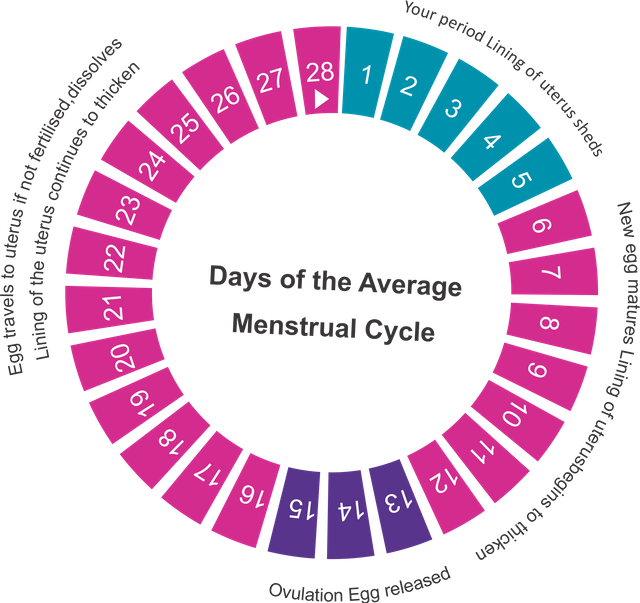How to detect ovulation

What is ovulation?
Ovulation takes place when you release an egg from one of your ovaries. If the egg is fertilized by a sperm and implanted in your uterus, you will have become pregnant!
Your most fertile stage is potentially five days before ovulation until the day of ovulation. But in the last 3 days of that period, it is when there are many more chances that you get pregnant.
There is no foolproof way to predict when you will ovulate. But there are some ways that can help you calculate when ovulation is most likely to occur. That way you can make your sexual relationships coincide with that moment and increase your chances of getting pregnant.
The calendar method
If your menstrual clique is regular (it lasts the same number of days each time it happens), you can try the calendar method (also called the rhythm method).
To calculate when you will ovulate, count back 14 days from the date when you wait for your next menstrual cycle. Your most fertile period includes the day you ovulate and the five days before that date. For example, if day 1 is the first day of your menstrual period and day 28 is the last day before your next period, it means that you will be more fertile between days 10 and 15.
This is the simplest way to calculate when You will ovulate though it is not very accurate, even if you have a good idea of when your next period will start. This is because ovulation rarely occurs exactly 14 days before your menstrual cycle.
In an extensive study among women whose menstrual cycles last 28 days, it was found that the day on which ovulation occurred varied between seven and 19 days before the menstrual period. Ovulation was carried out 14 days before the menstrual period 10 percent of the time.
That shows that you can completely pass your most fertile stage if you use this method. On the other hand, this method is free and easy so it is worthwhile to try it, especially if you are not in a hurry to conceive.
You can use our ovulation calculator to discover the days when you will probably be more fertile according to the calendrical method. That tool will also tell you what your likely date of delivery will be if you conceive.
Use tests to detect ovulation
Another method is ovulation tests that detect your hormone levels. You can find two types: the most common is the one that detects the hormonal levels in your urine, and the other one does it through saliva.
Both show a positive result days before you ovulate, so you have some time to plan sex with your partner.
Urine tests (consisting of disposable strips) tell you if there is an increase in luteinizing hormone (LH), which usually means that one of your ovaries will soon release an egg.
For the saliva test a microscope is used to analyze a pattern in your saliva that indicates an increase in estrogen, which happens in the days before ovulation.
These tests are sold in pharmacies and stores without a prescription. Keep in mind that they can be expensive (in the United States they cost between $ 20 and $ 50 dollars).
Registers the symptoms of ovulation
You can also record light patterns of your body temperature and your vaginal discharge for a few cycles to determine when to ovulate.
If you pay attention to these symptoms and write them down on a chart, you may begin to notice a pattern that will help you predict your next ovulation period. However, if your periods are irregular, you may not identify a pattern.
Your basal temperature is the lowest in your body during a 24-hour period. Take the temperature every morning with a special thermometer and record it on a graph. The day after you ovulate you should see a rebound of about 1 to 5 tenths in degrees Celsius (0.5 and 1.0 degrees Fahrenheit) at your basal body temperature.
The increase in temperature indicates that you have ovulated, because the release of an egg stimulates the production of the hormone progesterone, which increases body temperature.
Cervical mucus is the vaginal discharge that you sometimes find in your underwear. During most of the month, you may notice very little of this cervical mucus or it may be very sticky and thick.
But in the three or four days before, after and immediately after ovulation occurs, you will notice an increase in your cervical mucus and a change in its texture. It will be clear, slippery and elastic. It will resemble in appearance and texture to egg white when raw.
Keeping a record is free (of course, after buying the thermometer) but keep in mind that this method takes time and effort to do it in the most correct way possible.
Note if you have mild colic
**Some women report mild cramping, throbbing abdominal pain, or pain in the side of the back around the days they are ovulating. These sensations or symptoms are known as mittelschmerz (meaning "medium pain" in German).
Although this is not exactly a way to determine when you are ovulated, it will be helpful to be aware of these symptoms (if you have them) while using any of the methods to detect ovulation described in this article.**